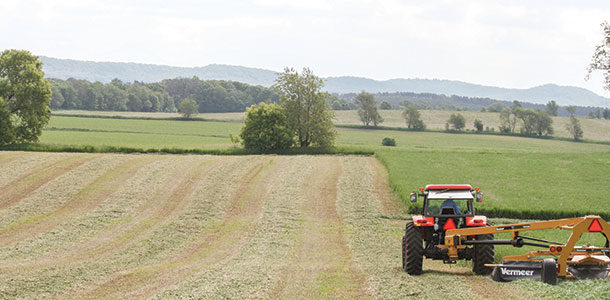Alfalfa, the “queen of forages,” finds its way into a majority of dairy rations in the U.S. not only because of its feed attributes but also due to its adaptability for growing and broad availability for purchase. Alfalfa is adapted throughout all U.S. regions and is suited to most soils with adequate drainage.
Compared to most grass forages at similar maturity, including the non-grain forage fraction of corn silage, dairy-quality alfalfa hay and haylage can be characterized as having:
- High proportion of highly digestible cell contents
- High protein content
- High proportion of soluble protein and potential rumen-degradable protein (RDP)
- Faster digestion rate of neutral detergent fiber (NDF)
- Lesser extent of NDF digestion
- Faster rate of rumen passage
- Stimulates less cud chewing
- Increased buffering capacity
Alfalfa packs a crude protein wallop like few other forages, providing a great combination of forage yield and relatively high crude protein.
No other forage can consistently deliver 20 percent crude protein while yielding 3 to 5 tons of dry matter under good agronomic management in the Northeast and Upper Midwest; the results are even higher in the irrigated West. In fact, no other crop yields as much crude protein per acre as alfalfa.
A good crop of alfalfa producing 5 tons of dry matter per acre with 20 percent protein generates 2,000 pounds of protein per acre. By comparison, soybeans yielding 50 bushels per acre weigh in at 935 pounds of protein – less than half alfalfa’s protein output.
Alfalfa is a wise choice for on-farm protein production, reducing the need for purchased protein sources – up to a point. Experts often suggest alfalfa inclusion levels in a practical working range of 25 to 75 percent of the forage fraction of dairy diets, both for feed efficiency and ease of ration formulation.
Alfalfa often has a high percentage of soluble protein and RDP as compared to other forages and protein sources. Alfalfa’s soluble protein contributes to a high proportion of RDP, available to microbes in the rumen. But RDP can vary depending on crop maturity and storage. Cutting at earlier maturity for dairy-quality alfalfa hay and haylage contributes to higher RDP.
Immature forages contain more non-protein nitrogen primarily composed of ammonia, nitrate, amines, amides and free amino acids, which are rapidly degradable in the rumen. Thus, high inclusion levels of dairy-quality alfalfa in dairy diets can contribute to increased non-protein nitrogen (NPN).
This may be further increased when proteolysis occurs during ensiling, as can happen with the soluble protein fractions in alfalfa. By contrast, RDP is usually found less in grass haylage because the percentage of soluble protein is often less. RDP is also less likely in red clover and birdsfoot trefoil because of association with compounds that slow proteolysis.
Be aware of the potential for unutilized RDP and NPN when rations include a high percentage of high-quality alfalfa. This can occur with high inclusion rates of alfalfa hay, and is even more likely with high-quality alfalfa haylage or baleage at high inclusion rates. The same potential exists with cows on pasture consuming a high proportion of fresh alfalfa in their diet.
Surplus RDP in feed can result in ammonia release in the rumen if not utilized by rumen microbial growth to synthesize microbial protein. This shows up as elevated milk urea nitrogen (MUN) levels in milk and can have a metabolic cost of excess N excretion in urine.
Thus, elevated MUN can be a signal to reduce RDP or to substitute a portion of RDP or NPN sources with protein sources having more rumen-undegradable (bypass) protein.
Corn gluten meal, DDGS, fish meal, blood meal and commercial bypass protein sources are examples that can replace some of the NPN and soluble protein sources to achieve a more desirable balance of rumen-degradable and rumen-undegradable protein.
Another strategy for dealing with surplus RDP is to utilize more of it by promoting more rapid rumen microbial growth to offset potential ammonia release from soluble-protein RDP and NPN sources.
This can be encouraged by adding readily fermentable non-fiber carbohydrates, such as molasses, high-moisture corn, steam-flaked corn, ground small grains, bakery byproducts, etc. This strategy seeks to make more efficient use of NPN from the soluble fraction of alfalfa protein.
It must also be accompanied by strict attention to effective fiber levels in the ration; consider backing off other NFC components in the diet along with the possible use of buffers if you use this strategy.
Advancing alfalfa maturity reduces crude protein percentage and lowers the percentage of soluble protein and RDP. With advancing maturity, true plant protein synthesis advances and the cell-wall matrix becomes more complex, rendering forage protein less accessible to rumen bacteria and less degradable.
These factors ultimately reduce degradation potential of forage proteins. Thus, advancing maturity in alfalfa increases the percentage of crude protein that is rumen-undegradable or bypass protein. At the same time, advancing maturity also “dilutes” the crude protein in forages with continuing accumulation of dry matter yield in the fiber fraction.
Advancing alfalfa maturity is associated with a decline in NDF digestibility, increasing acid detergent fiber (ADF) and NDF, and boosting lignin content. In alfalfa, the accumulation of yield includes both leaves and stems. Leaf dry matter accumulation slows and stabilizes after the bud stage. Leaves are roughly 40 percent protein and do not decline appreciably in protein content with advancing maturity.
Dry matter yield accumulation after the bud stage is primarily stems, with increasing ADF and lignin content, and decreasing NDF digestibility. Therefore, advancing maturity and stem yield accumulation dilutes the highly digestible leaf material.
These changes in the leaf-to-stem ratio and stem digestibility lead to an overall reduced rate and extent of fiber digestion. Similar changes in composition occur in other leguminous forage crops too, not just alfalfa.
The declining proportion of RDP coupled with overall declining percentage of protein in later-stage maturity alfalfa tends to reduce the soluble protein and RDP in alfalfa, lessening the need for ration adjustments for the sake of RDP.
These changes also limit the practical inclusion level of advancing maturity alfalfa in dairy rations, especially for high-producing cow groups.
This reduced inclusion coupled with lower protein content in advanced maturity hay or haylage leaves more room for other protein sources in the ration to achieve a desirable balance of rumen-degradable versus rumen-undegradable protein.
From an agronomic standpoint, alfalfa fits nicely into rotation with other crops that need nitrogen. It can provide more nitrogen for a following crop than any other leguminous species commonly grown in the U.S. What’s more, corn following alfalfa enjoys a yield boost that exceeds the nitrogen response.
It’s no surprise that alfalfa gets planted on a lot of acres because it not only fits with the forage and protein needs of dairy cows but also because it improves farm productivity. This can be especially true for farms with enough land to grow their own hay or haylage.
Alfalfa can be a key forage component in successful dairy diets. Inclusion levels can vary widely depending on availability, forage quality, commodity pricing and overall fit with other forages and feedstuffs in the diet.
High digestibility and relatively rapid ruminal passage of dairy-quality alfalfa permit high inclusion levels in diets, including high-producing cow groups. Ration adjustments may be needed to manage RDP, which can vary widely and may be high, especially in haylage.
Corn silage and alfalfa are a strong combination as main forages in dairy diets. Alfalfa’s high crude protein complements corn silage with its high starch content – starch that can have high rumen availability to augment rumen microbial RDP utilization if kernels in corn silage are well processed.
From a holistic farm management standpoint, maintaining alfalfa in rotation with corn is an efficient and profitable combination, especially on farms with sufficient land to grow the majority of their forage. PD
Photo by PD staff.

Robin Newell
Senior Forages Manager
DuPont Pioneer









